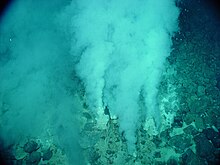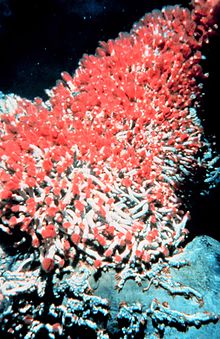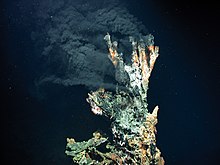Smoker (hydrothermal energy)

Black smoke and white smoke ( English black smoker and White Smoker ) belong to the hydrothermal springs at the bottom of the deep sea . Here, hot water, which contains various substances in solution , emerges and mixes with the colder surrounding water. In the process, dissolved substances separate into tubular mineral structures and form light or dark clouds as fine particles, depending on their composition. This creates the impression of a cloud of smoke that oozes out of the tubular or conical structure, which is therefore also called a chimney.
properties
Sulphides and other salts of iron , manganese , copper and zinc are mainly dissolved in the water released by smokers . The hot water of the thermal spring, which is over 300 ° C and rich in dissolved substances, meets the 2 ° C cold water of the sea bed . During the cooling process, minerals are precipitated as fine particles ; They form the outlet cone or chimney as well as its "smoke plume" through mineral separation. If this particle cloud is rich in iron salts (e.g. pyrite ), it has a characteristic black-gray color, which is why it is referred to as a "black smoker". If, on the other hand, large amounts of sulphates such as anhydrite and gypsum or silicon dioxide are dissolved in the thermal water that emerges , a light cloud of particles is formed, the cones are then referred to as "white smokers".

The two chimneys Two Boats and Sister Peaks on the Mid-Atlantic Ridge at a depth of 3000 meters reached the highest water temperatures that have so far been measured on black smokers : At a water pressure of 298 bar, they expel hot water in puffs of up to 464 ° C.
The chimneys of black smokers reach heights of around 20 to 25 meters on average. Hydrothermal springs with a different chemical composition, such as those of the Atlantic hydrothermal field Lost City , can form chimneys of up to 60 meters in height (as of 2001).
White smokers ( alkaline hydrothermal springs), on the other hand, are not directly driven by volcanism. Sea water penetrates through crevices into the olivine rock below and changes it through a chemical reaction to gray-green serpentine . The temperatures of the escaping water are significantly lower than that of black smokers, at 40 to 90 ° C. The pH value is basic .
Both black and white smokers can occur in a hydrothermal field. Black smokers generally represent chimneys close to the main upstream flow. White smokers are mostly found in the edge zones of such hydrothermal fields, at a certain distance from the igneous heat sources. Their hydrothermal water is dominated by sea water instead of igneous water. The mineral water from this type of chimney is rich in calcium and mainly forms sulphate-rich deposits ( barite and anhydrite) as well as carbonate deposits.
Smokers as biotopes

Hydrothermal deepwater sources and its surroundings form their own habitat with many, mostly living only in this environment types . Basis of the food chain in this habitat form chemolithotroph active bacteria and archaea that in the hot environment, the oxidation of hydrogen sulphide used as a source of energy to organic compounds from inorganic substances, including carbon dioxide as a carbon source to build. A green sulfur bacterium was discovered on a black smoker about 2,500 meters deep on the East Pacific ridge that carries out anoxygenic photosynthesis with hydrogen sulfide or sulfur as a reducing agent . No sunlight reaches the bacteria at this depth. Its extremely light-sensitive chlorosomes are able to absorb the thermal radiation (near infrared) from the hot hydrothermal solution emerging from the smoker and make it usable as an energy source for photosynthesis.
The biotope is also inhabited by spider crabs without eyes, Hoff crabs , yeti crabs , beard worms , clams , mussels and starfish . The beard worms living here do not have a digestive system , but get their nutrients from bacteria with which they live in symbiosis . These bacteria live in organs of the beard worms that are well supplied with blood, the so-called trophosomes , which means that the beard worms have direct access to the organic substances formed by the bacteria.
Fields of deep-sea hydrothermal springs are only active for about 20 years. Then the precipitated minerals clog the pipes and crevices and the springs dry up. This means that the fauna also dies in the environment that has now become hostile to life. How living things get to new fields of hydrothermal springs has not yet been researched. There are currently two different theories, both of which have not yet been adequately proven:
- The animals release their eggs into the surrounding water, through which they are then driven on over long distances by ocean currents. As soon as an egg reaches a hydrothermal spring with optimal living conditions, a larva grows from it.
- The adult animals are able to “jump” from source to source. Whale carcasses could act as “stepping stone biotopes” from one black smoker to the next. The researchers do not agree on exactly how this process takes place. No moving stages have been found either.
Black smokers are interesting for humans not only for ecological reasons, but also because of the ore deposits deposited in their vicinity. It is feared that the planned mining of gold and rare non-ferrous metals could impair or even destroy the ecosystems. The autonomous government of the Azores decided in 2002 to put two particularly important areas - the Lucky Strike and Menez Gwen hydrothermal fields - under protection as marine reserves.
Hypotheses on the evolution of life
The extreme environmental conditions, as they prevail in the hydrothermal fields of the deep sea near the black smokers, are reminiscent of the conditions in the early history of the earth , in which evolutionary biologists see the origin of earthly life. Volcanism with high temperatures and high pressure , lack of light and a high concentration of inorganic substances have induced some researchers (including Günter Wächtershäuser ) to assign the environment of black smokers a special meaning in the development of life.
The chemoautotrophically active bacteria and archaea from hydrothermal sources, the genome of which has been thoroughly examined and in many species has been completely deciphered, contributed in particular . They are considered by some researchers to be representative of the earliest forms of life because of their anaerobic metabolism and energy production without the ability to use sunlight, as well as their habitat, which was very common on early Earth.
Other organisms living in the vicinity of hydrothermal springs, such as the beard worms sitting in long tubes and Pompeii worms with reduced digestive organs or clams of the species Calyptogena magnifica , which live in symbiosis with chemoautotrophic sulfur bacteria , are highly specialized and adapted and more as products of a long evolution than as To denote origin. Overall, the black smokers, with their extraordinary ecosystem and new species, have sparked a lot of intensive discussions and further research among scientists in all areas of oceanography and geology , but also genetics , paleontology , microbiology , biochemistry and medicine since their discovery .
More recently, instead of black smokers, lime chimneys (alkaline hydrothermal chimneys or chimneys, including white smokers) such as Lost City on the Mid-Atlantic Ridge have come into focus, as the conditions there could possibly have been much more favorable for the development of life.
In another black smokers of the Mid-Atlantic Ridge, Loki's Castle (English: Loki's Castle ), were in 2015 by metagenomic analysis with the Lokiarchaeota found a new group of archaea that the eukaryotes - are closer than any other archaea previously known - living organisms with complex cell structure . In the meantime, other groups related to the Lokiarchaeota have also been found in other biotopes, but this does not rule out that further decisive steps in evolution - such as the emergence of eukaryotes - are connected with hydrothermal sources.
Some biologists expect similar life on ice moons of the gas planets like z. B. to find the Jupiter moon Europa or the Saturn moon Enceladus , since water oceans with hydrothermal springs are suspected there under the ice mantle.
See also
Other post-volcanic or thermal spring-related phenomena:
- Methane source
- Fumarole
- geyser
- Hot spring
- Cold water geyser
- Mofette
- Mud pot
- Solfatars
- Thermal spring
literature
- William Martin, Michael J. Russell: On the origins of cells: a hypothesis for the evolutionary transitions from abiotic geochemistry to chemoautotrophic prokaryotes, and from prokaryotes to nucleated cells. In: Philosophical Transactions of the Royal Society. Biological Sciences. Volume 358 (1429), 2003, pp. 59–85, PMID 12594918 , PMC 1693102 (free full text)
- William Martin et al. : Hydrothermal vents and the origin of life. In: Nature Reviews Microbiology . Volume 6, No. 11, 2008, pp. 805-814, PMID 18820700 , doi: 10.1038 / nrmicro1991 .
- Cindy L. Van Dover: The ecology of deep-sea hydrothermal vents. Princeton Univ. Press, Princeton 2000, ISBN 0-691-05780-X .
- David M. Karl: Microbiology of deep-sea hydrothermal vents. CRC Press, Boca Raton 1995, ISBN 0-8493-8860-0 .
- Gerald Traufetter: Snacking on Neptune's treasure . In: Der Spiegel . No. 40 , 2006, pp. 146-148 ( online ).
Web links
- Katharina Schöbi: Cool neighborhood - the sea worm Alvinella pompejana near hot thermal springs , Wissenschaft.de, May 3, 2005
- Heat record in the deep sea ( Memento from May 21, 2007 in the Internet Archive ). Netzeitung, June 22, 2006.
- Video black smokers: deep-sea ore factories . GEOMAR, 2012
- GS: Lexicon of Biology: Hydrothermal Springs , on Spektrum.de
- Jürgen Paeger: Still a mystery: The origin of life , on oekosystem-erde.de
- MARUM: Life in the deep sea - hot springs , on marum.de
Individual evidence
- ^ University of Delaware: Deep Ocean Chemistry
- ↑ Hottest water on earth , on: Wissenschaft aktuell
- ↑ Geotimes - 'Lost City' vents found
- ↑ a b Ute Kehse: The Origin , on: bdw online from May 15, 2012
- ↑ a b Nick Lane: The Spark of Life - Energy and Evolution , Konrad Theiss Verlag, (C) 2017 by WBG, ISBN 978-3-8062-3484-8 , Chapter 3: Energy and origin of life. Original English title: Nick Lane: The Vital Question - Energy, Evolution, and the Origins of Complex Life , Ww Norton, 2015-07-20, ISBN 978-0-393-08881-6 , PDF ( Memento of the original from 10 September 2017 in the Internet Archive ) Info: The archive link was inserted automatically and has not yet been checked. Please check the original and archive link according to the instructions and then remove this notice. . In the German edition it says 'alkaline hydrothermal vents' instead of correctly 'alkaline'.
- ↑ Colín-García, MA Heredia, G. Cordero, A. Camprubí, A. Negrón-Mendoza, F. Ortega-Gutiérrez, H. Beraldi and S. Ramos-Bernal: Hydrothermal vents and prebiotic chemistry: a review . In: Boletín de la Sociedad Geológica Mexicana . 68, No. 3, 2016, pp. 599‒620.
- ↑ Beatty, JT. et al . (2005): An obligately photosynthetic bacterial anaerobe from a deep-sea hydrothermal vent . In: Proc Natl Acad Sci USA 102 (26); 9306-9310; PMID 15967984 ; PDF (full text access)
- ↑ DPA: Bacteria: Photosynthesis in the deep sea. June 21, 2005, accessed May 20, 2019 .
- ↑ Die Zeit of March 4, 2011, "Raw Material Mining in the Pacific - The Treasure in the Deep Sea"
- ↑ Black smokers: cauldron of the deep sea. WWF Germany , January 8, 2014, accessed April 29, 2016 .
- ↑ Florian Guthknecht: On the trail of black smokers , Das Erste (BR) from October 23, 2011, accessed on August 18, 2017.
- ↑ Süddeutsche Zeitung online: Evolution: The debate about the place of origin , from February 20, 2017, updated on March 2, 2017.
- ↑ Moritz Nowack: Lost City , Spektrum.de of July 24, 2003, accessed on August 18, 2017.
- ↑ Joseph F. Sutherland: on The Origin Of Tha Bacteria And The Archaea , on BC of August 16, 2014.
- ↑ Anja Spang, Jimmy H. Saw, Steffen L. Jørgensen, Katarzyna Zaremba-Niedzwiedzka, Joran Martijn, Anders E. Lind, Roel van Eijk, Christa Schleper, Lionel Guy, Thijs JG Ettema: Complex archaea that bridge the gap between prokaryotes and eukaryotes . In: Nature . 521, 2015, ISSN 0028-0836 , pp. 173-179. doi : 10.1038 / nature14447 . PMID 25945739 . PMC 4444528 (free full text).
- ↑ K Zaremba-Niedzwiedzka et al at al: Asgard archaea illuminate the origin of eukaryotic cellular complexity . In: Nature . 541, 2017, pp. 353-358. doi : 10.1038 / nature21031 .
- ^ Karl Urban: Farewell to the habitable zone , on: Spektrum.de, from August 14, 2017
- ↑ AMQ : Habitable Zone and Tidal Heating , on: Spektrum.de, October 14, 2008.


